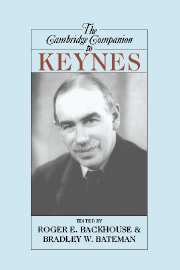Book contents
- Frontmatter
- 1 A cunning purchase: the life and work of Maynard Keynes
- 2 The Keynesian revolution
- 3 Keynes and the birth of modern macroeconomics
- 4 Keynes as a Marshallian
- 5 Doctor Keynes: economic theory in a diagnostic science
- 6 Keynes and British economic policy
- 7 Keynes and Cambridge
- 8 Keynes and his correspondence
- 9 Keynes and philosophers
- 10 Keynes’s political philosophy
- 11 Keynes and probability
- 12 The art of an ethical life: Keynes and Bloomsbury
- 13 Keynes and ethics
- 14 Keynes between modernism and post-modernism
- 15 Keynes and Keynesianism
- Bibliography
- Index
14 - Keynes between modernism and post-modernism
Published online by Cambridge University Press: 28 November 2006
- Frontmatter
- 1 A cunning purchase: the life and work of Maynard Keynes
- 2 The Keynesian revolution
- 3 Keynes and the birth of modern macroeconomics
- 4 Keynes as a Marshallian
- 5 Doctor Keynes: economic theory in a diagnostic science
- 6 Keynes and British economic policy
- 7 Keynes and Cambridge
- 8 Keynes and his correspondence
- 9 Keynes and philosophers
- 10 Keynes’s political philosophy
- 11 Keynes and probability
- 12 The art of an ethical life: Keynes and Bloomsbury
- 13 Keynes and ethics
- 14 Keynes between modernism and post-modernism
- 15 Keynes and Keynesianism
- Bibliography
- Index
Summary
INTRODUCTION
As an astute commentator on the economics of the early decades of the twentieth century has put it, the First World War acted as a watershed between an 'age of tranquility' and an 'age of turmoil' (Shackle 1967: 289). It marked a significant discontinuity in the intellectual, sociocultural and economic development of the Western hemisphere and beyond. The interwar period that followed witnessed severe financial crises and economic depression. In the wake of the Russian Revolution the world embarked on the competition of economic and political systems that dominated the twentieth century. At the same time, radio and television opened up the era of mass communication, which industrially was accompanied by the advent of mass production, brought to the consumer by ever more sophisticated uses of the new media for advertising. A solar eclipse in 1919 allowed adherents of Einstein's general theory of relativity to claim empirical confirmation of what newspapers around the world hailed as the overthrow of Newtonian physics, while Rutherford, building on his atomic model, eventually managed to split atoms. All these events and developments characterize the context of the culmination of modernism as a sociocultural style. In the world of fine arts Dadaism, expressionism and surrealism supplanted realist modes of representation. Similar shifts were experienced in architecture, literature, music and design.
- Type
- Chapter
- Information
- The Cambridge Companion to Keynes , pp. 257 - 270Publisher: Cambridge University PressPrint publication year: 2006
- 2
- Cited by

